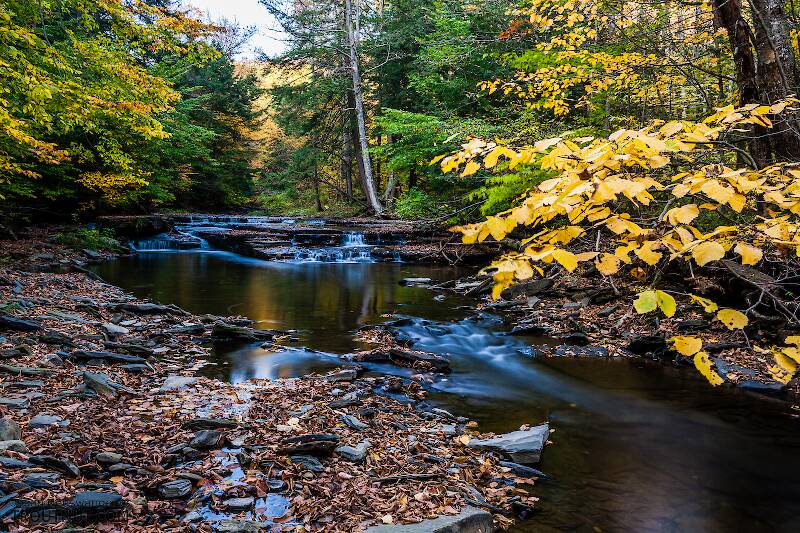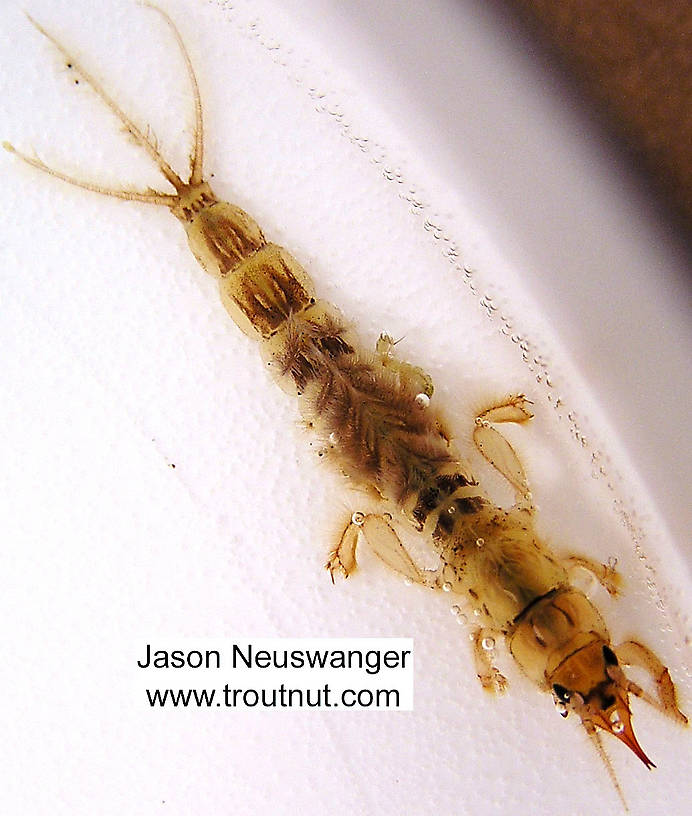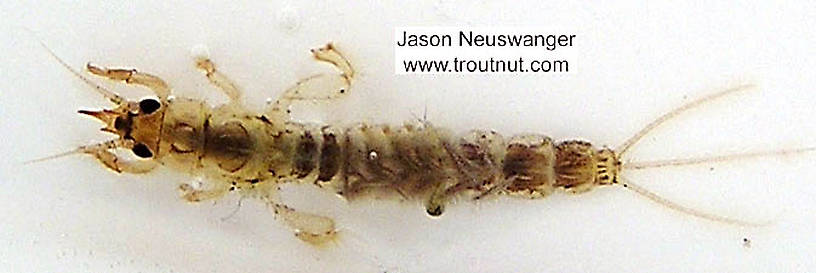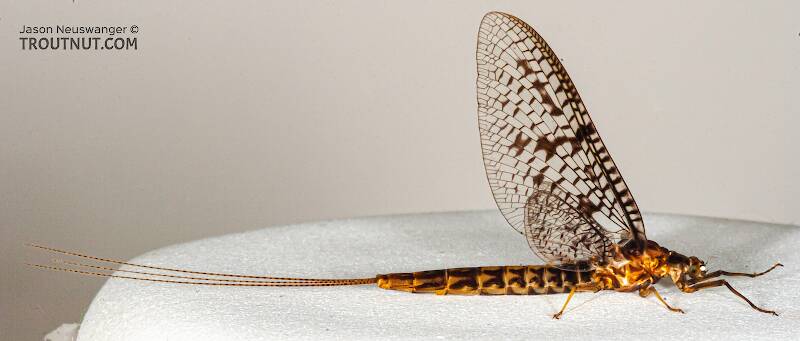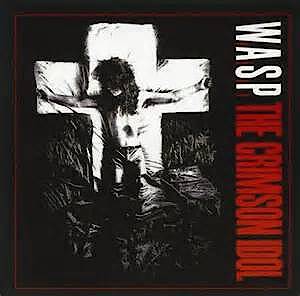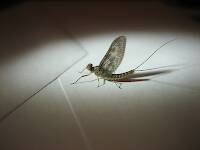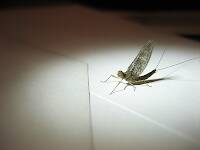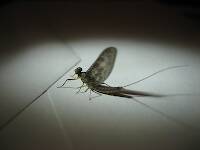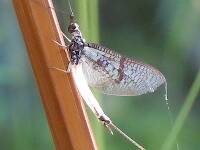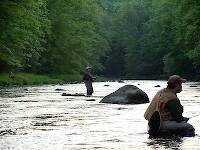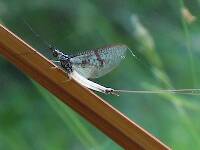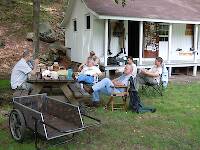
Salmonflies
Pteronarcys californica
The giant Salmonflies of the Western mountains are legendary for their proclivity to elicit consistent dry-fly action and ferocious strikes.
Featured on the forum

It's only barely visible in one of my pictures, but I confirmed under the microscope that this one has a prosternal horn and the antennae are mid-way between the eyes and front of the head capsule.
I'm calling this one Pycnopsyche, but it's a bit perplexing. It seems to key definitively to at least Couplet 8 of the Key to Genera of Limnephilidae Larvae. That narrows it down to three genera, and the case seems wrong for the other two. The case looks right for Pycnopsyche, and it fits one of the key characteristics: "Abdominal sternum II without chloride epithelium and abdominal segment IX with only single seta on each side of dorsal sclerite." However, the characteristic "metanotal sa1 sclerites not fused, although often contiguous" does not seem to fit well. Those sclerites sure look fused to me, although I can make out a thin groove in the touching halves in the anterior half under the microscope. Perhaps this is a regional variation.
The only species of Pycnopsyche documented in Washington state is Pycnopsyche guttifera, and the colors and markings around the head of this specimen seem to match very well a specimen of that species from Massachusetts on Bugguide. So I am placing it in that species for now.
Whatever species this is, I photographed another specimen of seemingly the same species from the same spot a couple months later.
I'm calling this one Pycnopsyche, but it's a bit perplexing. It seems to key definitively to at least Couplet 8 of the Key to Genera of Limnephilidae Larvae. That narrows it down to three genera, and the case seems wrong for the other two. The case looks right for Pycnopsyche, and it fits one of the key characteristics: "Abdominal sternum II without chloride epithelium and abdominal segment IX with only single seta on each side of dorsal sclerite." However, the characteristic "metanotal sa1 sclerites not fused, although often contiguous" does not seem to fit well. Those sclerites sure look fused to me, although I can make out a thin groove in the touching halves in the anterior half under the microscope. Perhaps this is a regional variation.
The only species of Pycnopsyche documented in Washington state is Pycnopsyche guttifera, and the colors and markings around the head of this specimen seem to match very well a specimen of that species from Massachusetts on Bugguide. So I am placing it in that species for now.
Whatever species this is, I photographed another specimen of seemingly the same species from the same spot a couple months later.

Troutnut is a project started in 2003 by salmonid ecologist Jason "Troutnut" Neuswanger to help anglers and
fly tyers unabashedly embrace the entomological side of the sport. Learn more about Troutnut or
support the project for an enhanced experience here.
This topic is about the Mayfly Species Ephemera simulans
The Brown Drakes are a favorite hatch of many in the Midwest, and they make a good showing on localized waters across the country. They are usually the first in a series of big drakes which bring large trout to the surface at twilight and into the early hours of the night. The experience can be much like fishing the Hexagenia limbata hatch, except that the nymphs seem to emerge from slightly more wadeable, sandy bottoms instead of the boot-sucking mud underlying the best Hex water. It will draw big trout out from the depths of a big pool to feed in the shallow tailout after dark.Example specimens
Derdmann on Jun 19, 2011June 19th, 2011, 4:37 pm EDT
Came across a mayfly on the Paint River by Crystal Falls, Michigan on June 17th. Is it a brown drake?
Thanks.
Thanks.
Taxon on Jun 19, 2011June 19th, 2011, 5:37 pm EDT
Yes, it's an Ephemera simulans male subimago.
Oldredbarn on Jun 19, 2011June 19th, 2011, 7:49 pm EDT
Doug,
Some very nice photos of the prince of Michigan mayflies! Is that bug beautiful or what!?
Chasing the Drakes...I know it's late but I've sat here for the last 30-40 minutes staring at what I just wrote...There is just too many things flooding through this old memory...This is the bug that is usually responsible for warping the brain of a Michigan fly fisherman and for making him a "night-owl". Normal folk just don't know about these wierd-o's wandering around in the middle of the night in a daze in pitch darkness...
Well actually we are lucky here in that we are at the tail end of our time zone and there is usually enough light at the beginning of it all to see what's up.
Well...Did you see any fish feeding?
The river has had a rough go of it this spring and things were running a little behind and I missed the Drakes in late May...Sometimes they can get started by late May.
Good stuff!
Spence
Some very nice photos of the prince of Michigan mayflies! Is that bug beautiful or what!?
Chasing the Drakes...I know it's late but I've sat here for the last 30-40 minutes staring at what I just wrote...There is just too many things flooding through this old memory...This is the bug that is usually responsible for warping the brain of a Michigan fly fisherman and for making him a "night-owl". Normal folk just don't know about these wierd-o's wandering around in the middle of the night in a daze in pitch darkness...
Well actually we are lucky here in that we are at the tail end of our time zone and there is usually enough light at the beginning of it all to see what's up.
Well...Did you see any fish feeding?
The river has had a rough go of it this spring and things were running a little behind and I missed the Drakes in late May...Sometimes they can get started by late May.
Good stuff!
Spence
"Even when my best efforts fail it's a satisfying challenge, and that, after all, is the essence of fly fishing." -Chauncy Lively
"Envy not the man who lives beside the river, but the man the river flows through." Joseph T Heywood
"Envy not the man who lives beside the river, but the man the river flows through." Joseph T Heywood
Adirman on Jun 20, 2011June 20th, 2011, 2:09 am EDT
How can you tell? It kinda looks like a March Brown to me cuz of the mottled wing color! I don't doubt your ID, just wondering what you look for for a postive ID.
Thanks,
Adirman
Thanks,
Adirman
Derdmann on Jun 20, 2011June 20th, 2011, 3:36 am EDT
We fished the South Branch during the day and a different, smaller stream at night. We did not see any brown drakes. These were stuck to the cabin when I woke up in the morning. I used a flash on some of those pictures and the wings look alittle different.
Oldredbarn on Jun 20, 2011June 20th, 2011, 6:42 am EDT
How can you tell? It kinda looks like a March Brown to me cuz of the mottled wing color! I don't doubt your ID, just wondering what you look for for a postive ID.
I'll leave the details to the pros on this site, they'll tell you the number of moles each one has :), but you can just take a look at Jason's Brown Drake on this site and his March Brown...Their coloration is quite different and Brown Drakes have three tails to M.B.'s two.
The March Brown, as Gonzo has said in his post a while back about the origins of our generic names, that the color "brown" isn't really the first impression of the March Brown and the name has been with us, for ever, lifted from the Brits. It's kind of a yellowish bug with very light brown hints.
The Brown Drake isn't all that "brown" either as you can tell in these photos, especially through the thorax. It's even more apparent in Jason's close ups. The Robert's Yellow Drake in the correct size is a pretty good match...The thorax is yellow thread and the abdomen is natural deer hair spiral wrapped to the rear of the fly...
Both the bugs have nice mottling in their wings but the Brown Drakes is a darker brown...In the "More Bugs" thread I have a picture of a March Brown I took this past May on the Au Sable.
My 2.5 cents...:)
Spence
"Even when my best efforts fail it's a satisfying challenge, and that, after all, is the essence of fly fishing." -Chauncy Lively
"Envy not the man who lives beside the river, but the man the river flows through." Joseph T Heywood
"Envy not the man who lives beside the river, but the man the river flows through." Joseph T Heywood
Oldredbarn on Jun 20, 2011June 20th, 2011, 6:56 am EDT
We fished the South Branch during the day and a different, smaller stream at night. We did not see any brown drakes. These were stuck to the cabin when I woke up in the morning.
Doug,
This is part of the deal with "chasing drakes"...That's how it goes. Sometimes they seem to always be happening where you are not fishing...I used to stay at some cabins in Lovell's Michigan on the North Branch of the Au Sable...The owner of the cabins loved telling me that he would have guys staying there for the drakes and they would run upstream on a rumor one night and downstream on another rumor the next...All along, he said, we had them right here on the river in front of the cabins.
The reward comes when you actually find yourself in the river and the sky just above your head is jammed with a zillion and one mating Brown Drakes! They are a nice bug to observe especially for a dry-fly-guy...They are big enough to actually see and you get the whole deal...duns stuck in their shucks, large duns on the water, and massive spinner falls. It's a lovely thing to witness. And fish just love them!
Spence
"Even when my best efforts fail it's a satisfying challenge, and that, after all, is the essence of fly fishing." -Chauncy Lively
"Envy not the man who lives beside the river, but the man the river flows through." Joseph T Heywood
"Envy not the man who lives beside the river, but the man the river flows through." Joseph T Heywood
Derdmann on Jun 20, 2011June 20th, 2011, 9:25 am EDT
Spence,
Not to get off topic, but I made my first trip this past May31-June 2 to Gates AuSable Lodge. I only got to fish 2 1/2 days because my wife was with me. I fished the "Holy Waters" and didn't do very well. A bunch of little fish. Managed 1-16" brown one morning. Sulphurs were hatching in the evening.
We did drive around and I did look at alot of the water. Checked out Bud's Cabins on the North Branch. Some nice looking water on the South Branch and the North Branch. The entire system has great looking water and I am planning on going back for a week (without the wife) next May/June. May split my stay between Gates Lodge and Bud's Cabin's.
Russ Bouck of Amherst Junction, Wisconsin gave a talk this past winter on the AuSable and that is what turned me on to trying this area.
Doug
Not to get off topic, but I made my first trip this past May31-June 2 to Gates AuSable Lodge. I only got to fish 2 1/2 days because my wife was with me. I fished the "Holy Waters" and didn't do very well. A bunch of little fish. Managed 1-16" brown one morning. Sulphurs were hatching in the evening.
We did drive around and I did look at alot of the water. Checked out Bud's Cabins on the North Branch. Some nice looking water on the South Branch and the North Branch. The entire system has great looking water and I am planning on going back for a week (without the wife) next May/June. May split my stay between Gates Lodge and Bud's Cabin's.
Russ Bouck of Amherst Junction, Wisconsin gave a talk this past winter on the AuSable and that is what turned me on to trying this area.
Doug
Entoman on Jun 20, 2011June 20th, 2011, 9:26 am EDT
Adirman -
Besides tail counts, Ephemerids (Brown Drakes, et. al.) differ from Heptagenids (March Browns, et. al.) in a number of significant ways. These differences once learned make them easy to differentiate at a glance, even in black and white photos or if a tail or two are missing. Going by color (and sometimes even size) can mislead. Without getting into the moles and stuff that Spence mentioned (a metaphor for scientific descriptive jargon not to be taken literally), the easiest way is to notice the following differences:
1. The abdomens of Ephemerids have less taper in the segments.
2. " " are much longer than the thorax.
3. " " are much closer in diameter to the thorax.
4. The legs are much shorter and heads much smaller with Ephemerids, relatively speaking.
5. The wings are much shorter and not as wide at their bases relative to body length with Ephemerids.
Get two images up on your screen and compare them both. The above differences will become readily apparent.
Regards,
Kurt
How can you tell? It kinda looks like a March Brown to me cuz of the mottled wing color! I don't doubt your ID, just wondering what you look for for a postive ID
Besides tail counts, Ephemerids (Brown Drakes, et. al.) differ from Heptagenids (March Browns, et. al.) in a number of significant ways. These differences once learned make them easy to differentiate at a glance, even in black and white photos or if a tail or two are missing. Going by color (and sometimes even size) can mislead. Without getting into the moles and stuff that Spence mentioned (a metaphor for scientific descriptive jargon not to be taken literally), the easiest way is to notice the following differences:
1. The abdomens of Ephemerids have less taper in the segments.
2. " " are much longer than the thorax.
3. " " are much closer in diameter to the thorax.
4. The legs are much shorter and heads much smaller with Ephemerids, relatively speaking.
5. The wings are much shorter and not as wide at their bases relative to body length with Ephemerids.
Get two images up on your screen and compare them both. The above differences will become readily apparent.
Regards,
Kurt
"It's not that I find fishing so important, it's just that I find all other endeavors of Man equally unimportant... And not nearly as much fun!" Robert Traver, Anatomy of a Fisherman
Oldredbarn on Jun 20, 2011June 20th, 2011, 9:53 am EDT
but I made my first trip this past May31-June 2 to Gates AuSable Lodge
You just missed me then! I drove home the Sunday of the Memorial weekend.
Unfortunately the river has seen near record levels of water (rain) this spring...Opening Day it was down right dangerous and still rough a few weeks later when I arrived back up there. I was there starting on the 18th of May. Every evening I'd pretty much fall out, sometimes with my clothes still on, from fighting the river all damn day.
Normally I would see the start of Brown Drakes near the end of my stay when my week ends up nearer to the end of the month of May like it did this year. Some years Memorial Day's almost a week earlier and I'd miss them. Well I missed them this year probably due to the funky weather.
I meant to stop at Bud's sometime when I was up. The Bud in Bud's Cabins sold the place sometime between 2002-and now. After his wife Harriet passed away. I noticed that his sign was blown over and I wasn't sure it was still in business.
It was a hoot right after the place was sold. The new owners sat a revolving camera in one of the cabins, out in the drive, and over by the Riverside Tavern for a "virtual tour" of Bud's! This place is just about as rustic as it gets and to see that new-fangled technology at work was quite funny.
PM me if you are going to be up that way next spring. I have read Ross Mueller's book on Mid-Western Flies from up your way. He spent some time around Grayling preparing for his book.
Take Care!
Spence
"Even when my best efforts fail it's a satisfying challenge, and that, after all, is the essence of fly fishing." -Chauncy Lively
"Envy not the man who lives beside the river, but the man the river flows through." Joseph T Heywood
"Envy not the man who lives beside the river, but the man the river flows through." Joseph T Heywood
Entoman on Jun 21, 2011June 21st, 2011, 8:52 pm EDT
Spence -
BTW, you guys in MI are very lucky to have both in your neck of the woods. Out West we have the big Yellow Drakes on the coast with the Browns pretty much a Rocky Mtn. bug. Do They hatch at the same time but in different sections or rivers?
Kurt
BTW, you guys in MI are very lucky to have both in your neck of the woods. Out West we have the big Yellow Drakes on the coast with the Browns pretty much a Rocky Mtn. bug. Do They hatch at the same time but in different sections or rivers?
Kurt
"It's not that I find fishing so important, it's just that I find all other endeavors of Man equally unimportant... And not nearly as much fun!" Robert Traver, Anatomy of a Fisherman
Troutnut on Jun 26, 2011June 26th, 2011, 2:55 pm EDT
Since others have given great technical lists of the difference between brown drakes and march browns (or the families Ephemeridae and Heptageniidae in general), I'll just give an easy, fuzzy description. Brown drakes (and other Ephemerids) are really lanky... long abdomens without much taper. March browns (and most other Heptageniids) are chunkier, and their legs are sort of more spread out and flat and crab-like, because they come from clinger nymphs. If you look at them side by side you'll see what I mean, and after that it's pretty easy to tell them apart at a glance, even when they're flying by in the air.
Jason Neuswanger, Ph.D.
Troutnut and salmonid ecologist
Troutnut and salmonid ecologist
Oldredbarn on Jun 27, 2011June 27th, 2011, 10:15 am EDT
BTW, you guys in MI are very lucky to have both in your neck of the woods.
Kurt,
Sometimes I think we over look just how damn lucky we really are up there! Take that sweetheart of a river for granted, we do.
I just got back from a four night get-away up there again and I couldn't believe the variety of hatching bugs we had...Thursday we suffered through a low pressure system right over my head and one moment the sun came out and the next moment it was pouring rain all damn day. It finally eased up toward evening...But I got a PM from Tim Neal who fished that day and he did very well. I had bugs galore with not a great deal of larger fish feeding on them but I caught enough to keep me out there all day. (Tim and I were out there probably for the most part alone with the river to ourselves while others were sleeping off last nights Hex madness and dreaming of big flies/big fish).
During the rain we had the larger Light Hennies still (invaria), the little sulphers (dorothea), a couple Baetis and maybe the Pseudocleon( I know we changed its name), a few Light Cahill's, there were Iso's, Gray Drakes (Gonzo prefers Grey Drakes :)), in the middle of the night Hex! Little yellow stones and a few of the dorsata hanging around...a few caddis and hell I even had a Dobson fly land on me and that maybe a first for me.
In regards to your question about March Brown/Brown Drakes and where they occur in the river. I am going to go out a bit on a limb here and maybe Tim Neal and/or Gonzo can fill in the blanks, agree with me or not. The Au Sable is not a limited river where it has basically all the same habitat. It has a variety of different charateristics that are repeated over and over again downstream. (I'm talking here about the river in the flies only traditional fly fishing stretches up by Grayling (North, South and Holy Water).
Riffle, runs, pools, nice deep bends, and gravel bottom throughout. Along the edges you get sand, marl banks, and the muckier habitat where the burrowing bugs hang. So, when most folks up there talk about Hex water they are talking way down from where I usually fish, but the habitat for Hex, for example, is throughout the system. Those pictures I posted last year of L. recurvata were taken in the middle of the Holy Water and they were hatching from a smallish patch of muck up under some tag alders along the bank.
So, there is habitat for the March Browns (clinging type) and sandy/soft burrowing habitat for the Brown Drakes all along the river happening over and over again as you move downstream. Where I'm going out on the limb is that for a good many angler's (not all of course) I think the March Brown gets over looked sometimes. I think that some of the success for the smaller Robert's Drakes is due to the March Brown...Everyone talks about the yellow stones/sulphers/yellowish Brown Drake/ etc all being around at the same time, but so is the March Brown.
We have all heard about the massive spinner flights of Hennies (both light & dark), the Brown Drakes, and the Hex...but I think that the March Brown's being overlooked here somewhat has to do with its hatching behavior. They are sporactic hatchers and spit out all day & night a little at a time mixed in with invaria etc...Folks see large hatches and spinner flights of other bugs and get mesmorized by them...I have sat on the bank and watched female March Browns on the down stream side of wind protecting trees depositing their eggs in tiny little areas of broken water all day! One at a time or a few here and there...
The fish see them all the time! Let's not call it selectivity just familiarity...:) The angler is busy out in the middle of the river slashing away and telling his pals about the great sulpher hatch but missing the March Brown activity. A March Brown something-or-other is a great searching fly when nothing else seems to be going on in May/June.
Sorry for the ramble...I'm still on river time and my heads still humming and I wish I was still there...:) Don't tell my wife, I just got home for goodness sakes!
Spence
"Even when my best efforts fail it's a satisfying challenge, and that, after all, is the essence of fly fishing." -Chauncy Lively
"Envy not the man who lives beside the river, but the man the river flows through." Joseph T Heywood
"Envy not the man who lives beside the river, but the man the river flows through." Joseph T Heywood
Entoman on Jun 27, 2011June 27th, 2011, 11:49 am EDT
Good info. The best of both worlds... Bug diversity of a freestone, numbers of a spring fed. Sounds like you could run into almost anything on a given day. I probably couldn't get away with my usual box or two of flies for the predictable as I'm used to. Gotta fish it some day.
Our freestones are still blown out. Spending my time on a few famous spring creeks to the north that are getting incredible pressure right now for lack of options. The fishing has actually been very good as the crowds have forced me out of my typical practices to work what most would think of as marginal spots or tactics.
Kurt
Our freestones are still blown out. Spending my time on a few famous spring creeks to the north that are getting incredible pressure right now for lack of options. The fishing has actually been very good as the crowds have forced me out of my typical practices to work what most would think of as marginal spots or tactics.
Kurt
"It's not that I find fishing so important, it's just that I find all other endeavors of Man equally unimportant... And not nearly as much fun!" Robert Traver, Anatomy of a Fisherman
Oldredbarn on Jun 27, 2011June 27th, 2011, 12:29 pm EDT
Bug diversity of a freestone, numbers of a spring fed. Sounds like you could run into almost anything on a given day. I probably couldn't get away with my usual box or two of flies for the predictable as I'm used to. Gotta fish it some day.
Anytime mister!
Here's the trick...You bring your predictables and stay close to Spence for the obscuranta! :) That way you have preserved your back & shoulders and in a pinch, somewhere in that tonnage he calls a fishing vest, he just may have what we need...
Spence
Once I get a few free minutes I'm going to read the Dobson Fly post...I actually had one land on me when I was floating Saturday night and I can't remember seeing one before. I know guys who harvest the Hellgamites and use them as bait for smallies.
"Even when my best efforts fail it's a satisfying challenge, and that, after all, is the essence of fly fishing." -Chauncy Lively
"Envy not the man who lives beside the river, but the man the river flows through." Joseph T Heywood
"Envy not the man who lives beside the river, but the man the river flows through." Joseph T Heywood
TNEAL on Jun 27, 2011June 27th, 2011, 1:09 pm EDT
Spence's comments about the March Brown are right on... in fact, if your're fishing in a nice hatch of sulphurs and not moving fish, switch to a size #12 or even #10 mMarch Brown pattern; at times the fish (esp. larger ones) are simply looking for something bigger.
I noted a comment about how fortunate we are to have both ( March Browns and Brown Drakes , I think) up here... for those of you who have never been here, the AuSable (Michigan) is nothing short of an insect factory. You will be amaed by sheer numbers of emeging insects.
Tim
I noted a comment about how fortunate we are to have both ( March Browns and Brown Drakes , I think) up here... for those of you who have never been here, the AuSable (Michigan) is nothing short of an insect factory. You will be amaed by sheer numbers of emeging insects.
Tim
Entoman on Jun 27, 2011June 27th, 2011, 1:27 pm EDT
Hi Tim,
The reference was to having both Brown Drakes and the big Hexagenia Drakes in the same water. Out West, our big Ephemerids are isolated from each other. I think PA and other Eastern locations have the same blessing as well.
Kurt
The reference was to having both Brown Drakes and the big Hexagenia Drakes in the same water. Out West, our big Ephemerids are isolated from each other. I think PA and other Eastern locations have the same blessing as well.
Kurt
"It's not that I find fishing so important, it's just that I find all other endeavors of Man equally unimportant... And not nearly as much fun!" Robert Traver, Anatomy of a Fisherman
Gutcutter on Jun 28, 2011June 28th, 2011, 5:49 am EDT
I share those experiences with March Browns.
Without being too analytical, I always figured that they must taste better than the more numerous hatch of the day. Plus, they just drift for so long before they get off of the water. Must be an easy target. Best bang for the buck! The least amount of energy for the highest protein reward.
My opinion only and what makes me put on a "two dry fly rig" when they are out and about.
Rarely do the fish rise to the smaller trailing fly..
Without being too analytical, I always figured that they must taste better than the more numerous hatch of the day. Plus, they just drift for so long before they get off of the water. Must be an easy target. Best bang for the buck! The least amount of energy for the highest protein reward.
My opinion only and what makes me put on a "two dry fly rig" when they are out and about.
Rarely do the fish rise to the smaller trailing fly..
All men who fish may in turn be divided into two parts: those who fish for trout and those who don't. Trout fishermen are a race apart: they are a dedicated crew- indolent, improvident, and quietly mad.
-Robert Traver, Trout Madness
-Robert Traver, Trout Madness
Oldredbarn on Jun 28, 2011June 28th, 2011, 6:41 am EDT
makes me put on a "two dry fly rig" when they are out and about.
Rarely do the fish rise to the smaller trailing fly..
There you go Mr. Neal...I guess you and that crusty old J.R. buddy of yours are on to something..."Go big or stay home!"
Considering your comment re: "Bug Factory"...When I really think about the amount of protein that river manufactures I can hardly believe it. I wouldn't believe it except that I've seen it. I think sometimes that I have only seen larger hatches and a similar variety of hatches on the Henry's Fork.
You saw my short list of bugs I saw just on Thursday in the rain. I stood over a riffle between the end of Shaw Park & Lower TU and could not believe the different bugs...Those damn little tiny shits were flooding off and I said a little prayer, "Please don't let them get on those little things...Please!" :) All the while the Hex boys were snoozing back at the Lodge!
Only the caddis seemed in short supply and that was probably due to the weather being so bad. That little brown/tan 14/16 caddis with the really long antennae where about. The Little Yellow Stone was steady as usual...I was on the edge of what Rusty used to call "Stonefly Alley"...I can't tell you how many fish I've pulled from logs by just running the appropriate stone along it...Then later toward evening the big boys show up just before the Hex...Gray Drakes, Iso's...Who knows what else...It's wonderful!
I spotted a couple very large bugs over the river that may have been some sort of moth or that large Speckled Olive Dun...They looked like small wren size for goodness sake.
Anyway...It's a match-the-hatchers dream stream...
Spence
I have seen spinner clouds on the South where at first I thought fog had settled in only to see, on closer inspection, zillions of sulpher spinners...
I was upstream of Daisey Bend with Jim years back where we had parked the boat and we both got out and fished an invaria hatch second to none! We had bugs all over the boat, and ourselves, and I'd toss in the bubble stream my Sparkle Dun only to see it land between three naturals in front of it and four just behind it! My little fraud stuck out so bad even I could see the difference 30 feet away! :) We sat back and let it roll...Ate a sandwich and drank a beer or two and once it settled down went "head-hunting"...During the heaviest part of the hatch the fish were going nuts and intercepting the emerging flies before they hit the surface...Looked like damn piranha in there and the birds were having a feast as well. It was mayhem and then it quiets back down...Strange.
I sat on a little island on the North one time and there was a little pool next to it and tiny little waves kind of washed up like on a beach...Everytime a little wave approached 4-5 dorothea popped out like someone was performing a magic trick for me...Against the far bend the fish lined up for the dinner bell...
You know I'm still on river time in my head and had just better settle myself down or so many folks will be heading to Grayling the shopkeepers there will have to pay you and I some commission! :)
"Even when my best efforts fail it's a satisfying challenge, and that, after all, is the essence of fly fishing." -Chauncy Lively
"Envy not the man who lives beside the river, but the man the river flows through." Joseph T Heywood
"Envy not the man who lives beside the river, but the man the river flows through." Joseph T Heywood
TNEAL on Jun 29, 2011June 29th, 2011, 6:11 pm EDT
Kurt,
Our Brown Drakes and Hex overlap here to a certain extent, and , yes, on the same waters... not such a bad "problem" to have... much overlooked is that both will hatch a fair amount in the daytime especially in certain weather conditions... large fish can be caught consistently on dries on those days...
Tim
Our Brown Drakes and Hex overlap here to a certain extent, and , yes, on the same waters... not such a bad "problem" to have... much overlooked is that both will hatch a fair amount in the daytime especially in certain weather conditions... large fish can be caught consistently on dries on those days...
Tim
Quick Reply
Related Discussions
Topic
Replies
Last Reply
5
Jun 8, 2006
by Wiflyfisher
by Wiflyfisher
6
Jun 10, 2009
by Martinlf
by Martinlf
0
Jul 7, 2008
by Liljrob
by Liljrob

